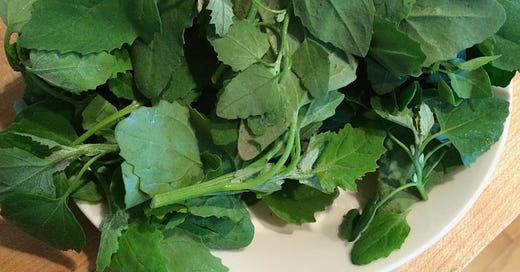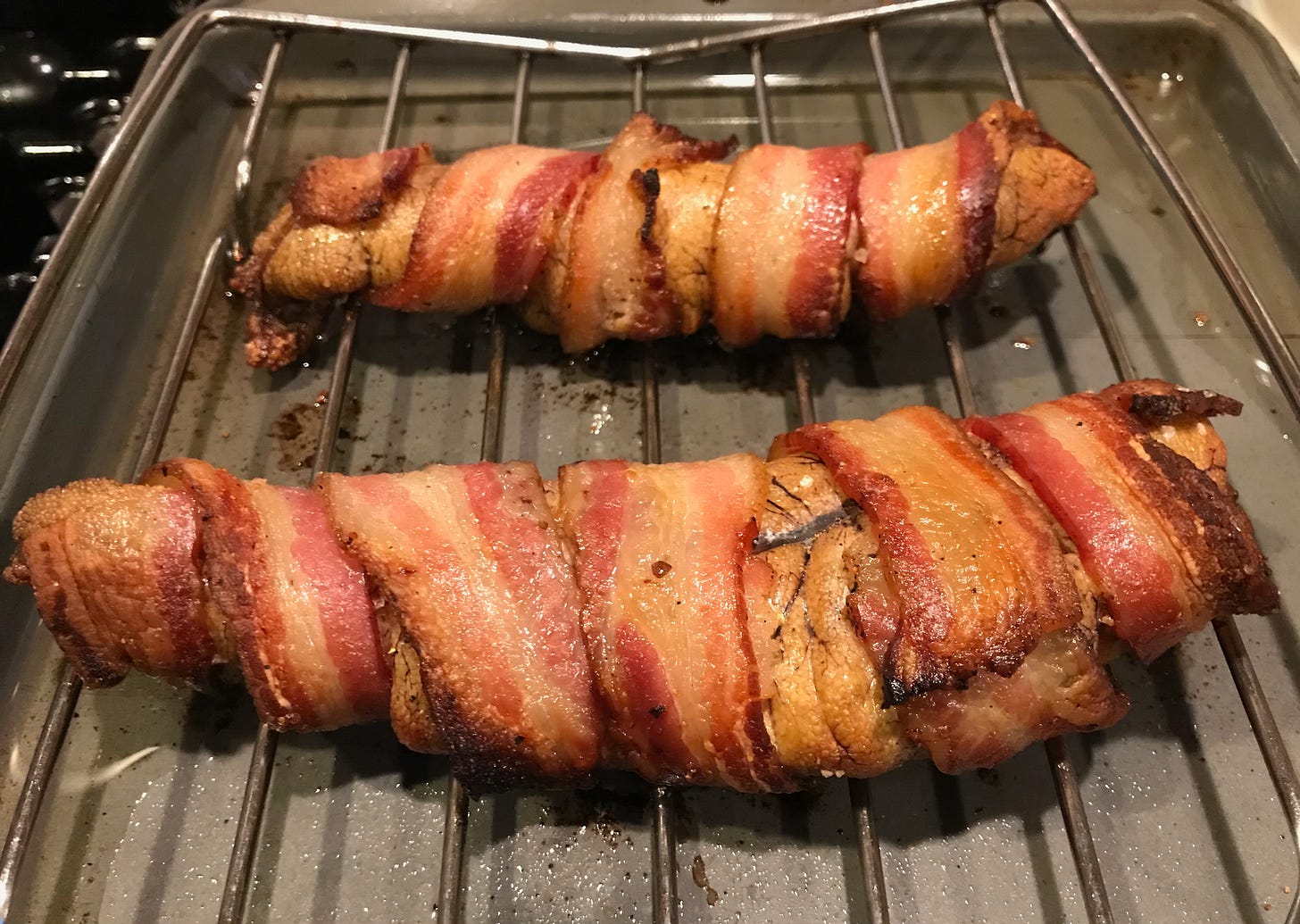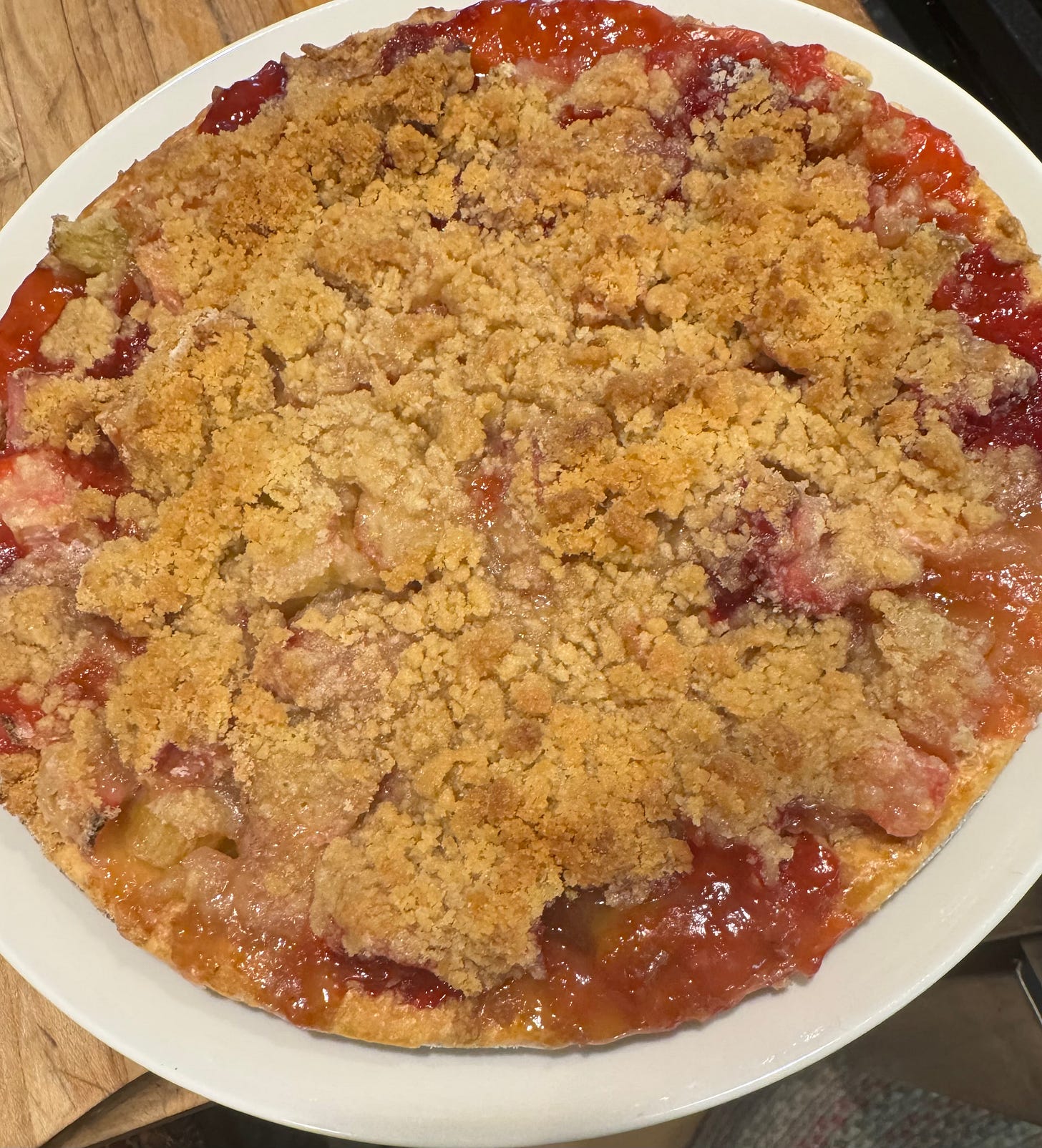Spring Will Be A Little Late This Year
Harvesting shad roe, fiddleheads, rhubarb, and, if you're lucky, maybe poulette grass

It’s been a cold, wet spring here in Maine, although the shimmering mosaic of greens elicited by the rain—from the soft golden sheen of birches to the dark forest spruce trees and every shade in between—is spectacular. But as a result, in the kitchen, in markets, on our tables, things are progressing very slowly.
We talk a good game about eating seasonally, but truth to tell, there’s not a whole lot of honestly seasonal things left in the food world, as a visit to my local, very well-stocked supermarket indicates. Eggplant and sweet peppers, onions and potatoes (even “new” potatoes), green beans and asparagus, all are available just about year round. Whether these out-of-season fruits and vegetables, transported in chilled containers over vast distances, actually taste of anything but cardboard—well, I leave you to be the judge. But the next time fresh local asparagus is available in your garden or farm market, taste it against the Mexican spears available in most supermarket produce sections. I think you’ll agree there’s a world of difference.
There are still, however, a few foods that are rigorously seasonal and, not surprisingly, they are almost all wild. No one has ever succeeded in producing out-of-season morel mushrooms and despite attempts to grow ramps (aka wild leeks or wild garlic) and fiddleheads (the early sprouts of ostrich ferns), these treasures are still only to be found in springtime, deep in the greening wildwoods.
There is one other spring food that I adore and that is rigorously seasonal at least on the East Coast of the U.S. It’s a harbinger of spring that begins as early as February down in South Carolina in the Pee Dee, Santee, and other rivers, and slowly makes its way up the East Coast to arrive in New England in May and June. That’s the annual run of big, graceful, slow-moving, silvery-skinned shad, that magnificent anadromous fish that once was so abundant in rivers like the Potomac, the Hudson, the Connecticut, and the Penobscot (just to mention a few). You can learn a lot more about shad from the estimable John McPhee, whose 26th (!) book, The Founding Fish, details the history of shad in American waters, from George Washington’s day to our own.
Waiter, bring me shad roe!
Actually, it’s not the fish that counts so much as it is the roe. In fact, I have only once prepared a whole shad; the fish are notoriously bony with rows of little Y- shaped spines that make eating a treacherous act. Back in the day, however, there was a lady fish monger in Cambridge, Massachusetts, who successfully boned out whole shad and presented them to her clientele. She was convinced—and she was right—that, apart from the bones, shad is a wonderful eating fish, with rich white fatty meat that recalls herring, a close cousin in the big Clupeid family. Indeed, in some parts of the country, shad are called river herring—but they are much bigger and more satisfying than common herring.
The real prize with shad, however, is the roe, the egg sac, which grows in two big ruby-red lobes inside each female fish. Sauteed or oven-roasted as simply as possible, nothing but salt and pepper, bacon and lemon juice, to adorn it, this is a dish I associate with old-fashioned, deeply traditional New York restaurants, the sort of thing you might have ordered along with soft-shell crabs or oyster pan roast at the Grand Central Oyster Bar or the erstwhile Brooklyn establishment Gage & Tollner. (Both institutions still exist but the classic traditions have long since gone missing.) In the immortal words of the ultimate New York sophisticate Cole Porter: “Why ask if shad do it? Waiter, bring me shad roe!” Fields of daffodils in blossom in Central Park, cherry trees blooming in the Brooklyn Botanical Gardens, a sea of bobbing umbrellas in a spring rain on Broadway, nothing for me evokes springtime in New York as much as the first shad roe in the markets and on the menus.
I actually learned to cook shad roe down in South Carolina late one winter when the shad had started to run up the Santee and Lucille Grant, a brilliant traditional Low Country cook, showed me how to prepare it. It is dead simple, effortless really, and the only point to remember is to separate the lobes and cut away the filament that clings to the margin between them. That’s easily done with kitchen shears. You should plan on serving one lobe per person and I should add that in Charleston this is often considered breakfast fare (well, it is eggs, after all) and served with an accompaniment of buttery grits.
When you’re ready to cook, heat your oven to 450ºF/230ºC. Generously sprinkle each lobe with salt and freshly ground black pepper and squeeze some fresh lemon juice over it. Take a couple of strips of thin-cut, country-style bacon, one slice for each lobe of roe. Stretch the bacon slices by pressing each strip with the flat blade of a knife, flattening and expanding it. Then wrap a strip of stretched bacon in a spiral around the lobe. Arrange the wrapped lobes on a shallow baking tray and transfer to the hot oven. After 10 minutes, the bacon should be showing signs of crispness and browning and the lobes should have changed color from dark mahogany to a rich brown. To check for doneness, cut away a little piece at the end. If it’s beige-y brown all the way through, it’s done. Any longer and it may be overcooked and dry.
Remove from the oven and serve immediately, with lemon quarters to add more juice. This is rich fare indeed. Breakfast makes sense because you can serve the seared shad roe with plenty of hot, black coffee, the perfect accompaniment.
Lovin’ that rhubarb pie. . . .
Rhubarb pie makes a great seasonal finish to a shad roe meal, the tart fruit acting as a fine contrast to the richness of the fish. It’s another spring treat that is tastiest when harvested right in your own neighborhood, rather than imported from Ecuador or Guatemala. I confess that I’m am not a big fan of most pies, the kind that have top and bottom crusts (well, apple pie, yes, if the crust is really buttery and flakey)—so much carbohydrate, it seems, just overwhelms the delicious fruit, whether strawberries, or peaches, or even lemons. So when I learned to make a pie with just a bottom crust, and a top that’s more like a crisp or a crumble, it changed my views. In France these days it’s very much a thing, to make un crumble (try saying that in French) for invited guests. So here’s how I make Un Crumble de Rhubarbe, or my version of rhubarb pie. The topping is what many cookbooks call a streusel top, basically just sugar, flour, and butter, creamed together and then crumbled over the fruit. It gives a nice crunchy texture and buttery flavors to the sometimes aggressive nature of rhubarb. I also find that adding a few cut-up strawberries helps to balance the taste.
Sorry, the rest of this post, including the recipe for that great rhubarb pie, is for paid subscribers only.
Keep reading with a 7-day free trial
Subscribe to On the Kitchen Porch to keep reading this post and get 7 days of free access to the full post archives.







